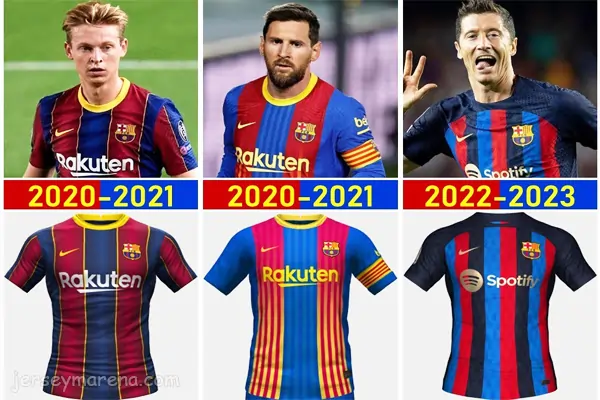FC Barcelona Kit History: Evolution of a Football Icon
The history of FC Barcelona’s kits is not just a timeline of fashion but a journey through football heritage, identity, and culture. As one of the most iconic football clubs in the world, FC Barcelona’s kit evolution reflects the team’s growth, changing aesthetics, technological advancements, and its symbolic representation of Catalan pride. This article offers a comprehensive and SEO-optimized look at the FC Barcelona Kit History, from its earliest designs to the most recent innovations.
Early Beginnings (1899 – 1920s) :
FC Barcelona was founded in 1899, and the team adopted the now famous blue and garnet (blaugrana) colors early on. These colors have remained a constant, though their arrangement and styling have changed over the decades. In the early years, the kits were simple: vertically striped shirts, long sleeves, and heavy cotton material, paired with plain white or black shorts.
1930s – 1950s: The Era of Tradition :
During the 1930s to the 1950s, the design of FC Barcelona’s kits remained relatively traditional. The vertical blaugrana stripes were firmly established, and minor changes in collar styles and sleeve lengths were introduced. The club began using better materials for comfort and durability. The badge, featuring the St. George’s Cross and Catalan flag, also became more standardized.
1960s – 1980s: Innovation Begins
The 1960s saw the introduction of more athletic-fitting kits, as polyester started replacing cotton. FC Barcelona also began to experiment subtly with stripe thickness and collar designs. The 1970s and 1980s saw more noticeable changes, such as the inclusion of player numbers on the front and back. The club maintained a no-sponsor policy during this time, enhancing the purity of the kit’s design.
1990s: The Commercial Era Begins
In the 1990s, FC Barcelona entered the commercial era of football. Nike became the club’s official kit supplier in 1998, introducing modern manufacturing techniques and new materials. The kits began to feature bolder designs and patterns, often incorporating sublimated graphics. While the blaugrana colors were still central, some away kits included yellows, oranges, and even silver tones.
2000s: A Balance of Heritage and Modernity
The 2000s were marked by a blend of classic styling and innovation. FC Barcelona finally added a shirt sponsor, UNICEF, in 2006 not for profit, but to promote the global organization. This move further emphasized the club’s commitment to social values. The kits during this era remained sleek, with sharper collars, breathable fabric, and more intricate designs.
2010s: Bold Designs and Global Influence
In the 2010s, FC Barcelona continued pushing design boundaries. In 2015, for the first time ever, the Home Kit featured horizontal stripes instead of vertical ones. This bold change sparked controversy but also showcased the club’s willingness to innovate. The club rotated through various sponsors including Qatar Airways and Rakuten, each adding their own branding to the shirt.
2020s: Sustainability and Modern Technology
Modern FC Barcelona kits incorporate sustainable materials, like recycled polyester, as part of Nike’s Move to Zero initiative. Recent designs have returned to traditional vertical stripes but with modern twists, including gradient effects and digital patterns. The use of Dri-FIT ADV technology ensures performance and comfort at the highest level.
Special Editions and Cultural Homages
Over the years, Barcelona has released several special edition kits. These include anniversary kits, tributes to Catalonia, and limited edition collaborations. Each of these tells a unique story, strengthening the emotional connection between the club and its global fanbase.
The History of FC Barcelona’s Kits mirrors the evolution of football itself. From humble beginnings to high-tech, sponsor-laden designs, each era of the Blaugrana kit tells a story of tradition, identity, and innovation. As the club continues to evolve, fans can expect the kits to remain a powerful symbol of pride and passion.

